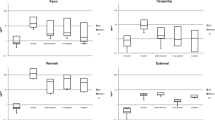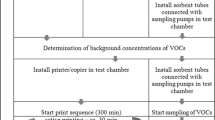Summary
The presence of organic solvents was investigated by means of environmental monitoring of the indoor air during one workweek in each of ten selected small screen printing plants and the houses surrounding them in the inner city of Amsterdam. In the indoor air of the screen printing plants, 14 to 17 organic solvents were identified. The concentrations of the identified organic solvents varied widely from sampling location and period. In the indoor air of the houses situated above the plants, zero to fifteen organic solvents were identified. The concentration of organic solvents in the indoor air of the houses situated above was related to the type of construction materials. The highest concentrations were found in the houses situated above moderately maintained screen printing plants with wooden floors and ceilings (n = 5). The concentration of organic solvents in the indoor air of the houses situated above well maintained screen printing plants with wooden floors and ceilings (n = 3) was much smaller, while the plants situated in concrete new buildings (n = 2) were not a source of organic solvents. The calculated effect specific exposure index (EI), assuming an additive effect and based on the effect specific limit values (ESLVs) for two critical effects [irritation mucous membranes and (pre) narcotic effects] exceeded unity in one workroom in two of the screen printing lants. The calculated EIs for the residents of the houses on the first floor, based on the same ESLVs, but adjusted to potential continuous exposure and interindividual differences in susceptibility, did not exceed unity. However, episodes of irritation of mucous membranes and (pre) narcotic effects may occur.
Similar content being viewed by others
References
Cherry N, Venables H, Waldron HA (1983) The acute behavioural effects of solvent exposure. J Soc Occup Med 33:13–18
Gezondheidsraad (1985) Recommendations concerning the basic assumption of threshold values (in Dutch) 's-Gravenhage
Kurppa K, Husman K (1982) Car painters' exposure to a mixture of organic solvents. Scand J Work Environ Health 8:137–140
Lebret E (1985) Air pollution in Dutch homes: an exploratory study in environmental epidemiology. Agricultural University, Wageningen
Lindström K (1981) Behavioral changes after long-term exposure to organic solvents and their mixtures. Scand J Work Environ Health [Suppl 7] 4:48–53
Monster AC, Smolders JFJ (1983) Tetrachloroethene in exhaled air of persons living near a pollution source. Int Arch Occup Environ Health 53:331–336
Muelkes FX, Miller JA (1979) Determination of airborne organic vapor mixtures using charcoal tubes. Am Ind Hyg Assoc J 40:380–386
NIOSH (1977) Manual of analytical methods, Vol. 1; 2nd edn. DHEW, Cincinnati
Orbaek P, Risberg J, Rosén I, Haeger-Aronsen B, Hagstadius S, Hjortsberg U, Regnell G, Rehnström S, Svensson K, Welinder K (1985) Effects of long-term exposure to solvents in the paint industry. Scand J Work Environm Health [Suppl 2] 11
Orbaek P, Lindgren M, Olivecrona H, Haeger-Aronsen B (1987) Computed tomography and psychometric test performences in patients with solvent induced chronic toxic encephalopathy and healthy controls. Br J Ind Med 44:175–179
Otson R, Williams DT, Bothwell PP (1983) Charcoal tube technique for simultaneous determination of selected organics in air. Am Ind Hyg Assoc J 44:489–494
Paustenbach DJ (1985) Occupational exposure limits, pharmacokinetics and unusual work schedules. In: Patty's industrial hygiene and toxicology, vol. 3, 2nd ed. LJ Crally and LV Crally (eds) New York, Wiley
Samimi B (1982) Exposure to isophorone and other organic solvents in a screen printing plant. Am Ind Hyg Assoc J 43:43–49
Scheffers TML, Jongeneelen FJ, Bragt PC (1985) Development of effect-specific limit values (ESLVs) for solvent mixtures in painting. Ann Occup Hyg 29:191–199
Verberk MM, Scheffers TML (1980) Tetrachloroethylene in exhaled air of residents near dry-cleaning shops. Environ Res 21:432–437
Verhoeff AP, Wilders MMW (1985) Organic solvents in a carbody repair shop, an offset printing office and surrounding houses (in Dutch). University of Amsterdam, Amsterdam
Verhoeff AP, Wilders MMW, Monster AC, Wijnen JH van (1987) Organic solvents in the indoor air of two small factories and surrounding houses. Int Arch Occup Environ Health 59:153–163
Vliet C van, Swaen GMH, Slangen JJM, Boorder Tj de, Sturmans F (1987) The organic solvent syndrome. A comparison of cases with neuropsychiatric disorders among painters and construction workers. Int Arch Occup Environ Health 59:493–501
Author information
Authors and Affiliations
Rights and permissions
About this article
Cite this article
Verhoeff, A.P., Suk, J. & van Wijnen, J.H. Residential indoor air contamination by screen printing plants. Int Arch Occup Environ Health 60, 201–209 (1988). https://doi.org/10.1007/BF00378698
Received:
Accepted:
Issue Date:
DOI: https://doi.org/10.1007/BF00378698




